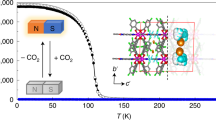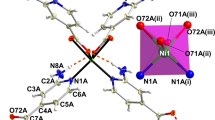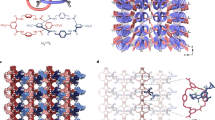Abstract
Chemical functionalization is a powerful approach to tailor the physical and chemical properties of two-dimensional (2D) materials, increase their processability and stability, tune their functionalities and, even, create new 2D materials. This is typically achieved through post-synthetic functionalization by anchoring molecules on the surface of an exfoliated 2D crystal, but it inevitably alters the long-range structural order of the material. Here we present a pre-synthetic approach that allows the isolation of crystalline, robust and magnetic functionalized monolayers of coordination polymers. A series of five isostructural layered magnetic coordination polymers based on Fe(ii) centres and different benzimidazole derivatives (bearing a Cl, H, CH3, Br or NH2 side group) were first prepared. On mechanical exfoliation, 2D materials are obtained that retain their long-range structural order and exhibit good mechanical and magnetic properties. This combination, together with the possibility to functionalize their surface at will, makes them good candidates to explore magnetism in the 2D limit and to fabricate mechanical resonators for selective gas sensing.
This is a preview of subscription content, access via your institution
Access options
Access Nature and 54 other Nature Portfolio journals
Get Nature+, our best-value online-access subscription
$29.99 / 30 days
cancel any time
Subscribe to this journal
Receive 12 print issues and online access
$259.00 per year
only $21.58 per issue
Buy this article
- Purchase on Springer Link
- Instant access to full article PDF
Prices may be subject to local taxes which are calculated during checkout





Similar content being viewed by others
References
Ferrari, A. C. et al. Science and technology roadmap for graphene, related two-dimensional crystals, and hybrid systems. Nanoscale 7, 4598–4810 (2015).
Dean, C. R. et al. Boron nitride substrates for high-quality graphene electronics. Nat. Nanotechnol. 5, 722–726 (2010).
Mañas-Valero, S., García-López, V., Cantarero, A. & Galbiati, M. Raman spectra of ZrS2 and ZrSe2 from bulk to atomically thin layers. Appl. Sci. 6, 264 (2016).
Mak, K. F., Lee, C., Hone, J., Shan, J. & Heinz, T. F. Atomically thin MoS2: a new direct-gap semiconductor. Phys. Rev. Lett. 105, 136805 (2010).
Carvalho, A. et al. Phosphorene: from theory to applications. Nat. Rev. Mater. 1, 16061 (2016).
Acerce, M., Voiry, D. & Chhowalla, M. Metallic 1T phase MoS2 nanosheets as supercapacitor electrode materials. Nat. Nanotech. 10, 313–318 (2015).
Xu, C. et al. Large-area high-quality 2D ultrathin Mo2C superconducting crystals. Nat. Mater. 14, 1135–1141 (2015).
El-Bana, M. S. et al. Superconductivity in two-dimensional NbSe2 field effect transistors. Supercond. Sci. Technol. 26, 125020 (2013).
Navarro-Moratalla, E. et al. Enhanced superconductivity in atomically thin TaS2. Nat. Commun. 7, 11043 (2016).
Hardy, W. J. et al. Thickness-dependent and magnetic-field-driven suppression of antiferromagnetic order in thin V5S8 single crystals. ACS Nano 10, 5941–5946 (2016).
Lee, J.-U. et al. Ising-type magnetic ordering in atomically thin FePS3. Nano Lett. 16, 7433–7438 (2016).
Gong, C. et al. Discovery of intrinsic ferromagnetism in two-dimensional van der Waals crystals. Nature 546, 265–269 (2017).
Huang, B. et al. Layer-dependent ferromagnetism in a van der Waals crystal down to the monolayer limit. Nature 546, 270–273 (2017).
Diercks, C. S. & Yaghi, O. M. The atom, the molecule, and the covalent organic framework. Science 355, 1585 (2017).
Liu, W. et al. A two-dimensional conjugated aromatic polymer via C–C coupling reaction. Nat. Chem. 9, 563–570 (2017).
Rodríguez-San-Miguel, D., Amo-Ochoa, P. & Zamora, F. MasterChem: cooking 2D-polymers. Chem. Commun. 52, 4113–27 (2016).
Peng, Y. et al. Metal–organic framework nanosheets as building blocks for molecular sieving membranes. Science 346, 1356–1359 (2014).
Rodenas, T. et al. Metal–organic framework nanosheets in polymer composite materials for gas separation. Nat. Mater. 14, 48–55 (2015).
Lahiri, N., Lotfizadeh, N., Tsuchikawa, R., Deshpande, V. V. & Louie, J. Hexaaminobenzene as a building block for a family of 2D coordination polymers. J. Am. Chem. Soc. 139, 19–22 (2017).
Araki, T., Kondo, A. & Maeda, K. The first lanthanide organophosphonate nanosheet by exfoliation of layered compounds. Chem. Commun. 49, 552–554 (2013).
Abhervé, A., Mañas-Valero, S., Clemente-León, M. & Coronado, E. Graphene related magnetic materials: micromechanical exfoliation of 2D layered magnets based on bimetallic anilate complexes with inserted [FeIII(acac2-trien)]+ and [FeIII(sal2-trien)]+ molecules. Chem. Sci. 6, 4665–4673 (2015).
Foster, J. A., Henke, S., Schneemann, A., Fischer, R. A. & Cheetham, A. K. Liquid exfoliation of alkyl-ether functionalised layered metal–organic frameworks to nanosheets. Chem. Commun. 52, 10474–10477 (2016).
Shi, W. et al. Surface modification of two-dimensional metal–organic layers creates biomimetic catalytic microenvironments for selective oxidation. Angew. Chem. Int. Ed. 56, 9704–9709 (2017).
Peng, Y. et al. Two-dimensional metal–organic framework nanosheets for membrane-based gas separation. Angew. Chem. Int. Ed. 56, 9757–9761 (2017).
Lei, S. et al. Surface functionalization of two-dimensional metal chalcogenides by Lewis acid-base chemistry. Nat. Nanotech. 11, 465–471 (2016).
Gaur, A. P. S. et al. Surface energy engineering for tunable wettability through controlled synthesis of MoS2. Nano Lett. 14, 4314–4321 (2014).
Faghani, A. et al. Controlled covalent functionalization of thermally reduced graphene oxide to generate defined bifunctional 2D nanomaterials. Angew. Chem. Int. Ed. 56, 2675–2679 (2017).
Rettig, S. J., Storr, A., Summers, D. A., Thompson, R. C. & Trotter, J. Transition metal azolates from metallocenes. 2. Synthesis, X-ray structure, and magnetic properties of a three-dimensional polymetallic iron(ii) imidazolate complex, a low-temperature weak ferromagnet. J. Am. Chem. Soc. 119, 8675–8680 (1997).
Lines, M. E. The quadratic-layer antiferromagnet. J. Phys. Chem. Solids 31, 101–116 (1970).
Nguyen, L. et al. Atomic defects and doping of monolayer NbSe2. ACS Nano 11, 2894–2904 (2017).
Rooney, A. P. et al. Observing imperfection in atomic interfaces for van der Waals heterostructures. Nano Lett. 17, 5222–5228 (2017).
Hartmann, U. Magnetic force microscopy. Annu. Rev. Mater. Sci. 29, 53–87 (1999).
Serri, M. et al. Low-temperature magnetic force microscopy on single molecule magnet-based microarrays. Nano Lett. 17, 1899–1905 (2017).
Zhu, X. et al. Signature of coexistence of superconductivity and ferromagnetism in two-dimensional NbSe2 triggered by surface molecular adsorption. Nat. Commun. 7, 11210 (2016).
Bunch, J. S. et al. Electromechanical resonators from graphene sheets. Science 315, 490–493 (2007).
Castellanos-Gomez, A. et al. Single-layer MoS2 mechanical resonators. Adv. Mater. 25, 6719–6723 (2013).
Hermosa, C. et al. Mechanical and optical properties of ultralarge flakes of a metal–organic framework with molecular thickness. Chem. Sci. 6, 2553–2558 (2015).
Britnell, L. et al. Strong light–matter interactions in heterostructures of atomically thin films. Science 340, 1311–1314 (2013).
Acknowledgements
The authors acknowledge financial support from the European Comission (COST Action MOLSPIN CA15128, FET-OPEN 2D-INK 664878, ERC-2016-CoG 724681-S-CAGE and ERC-2018-AdG 788222 Mol-2D), the Spanish MINECO (Structures of Excellence María de Maeztu MDM-2015–0538 and Severo Ochoa SEV-2012-0267, projects CTQ2014-59209-P, CTQ2017-89528-P, MAT2017-89993-R, MAT2015-68200-C2-2-P and MAT2015-71842-P), the Generalitat Valenciana (Prometeo programme) and the VLC/Campus Program. G.M.E. thanks the Spanish MINECO for a Ramón y Cajal Fellowship. S.M.V. thanks MINECO for a predoctoral FPU grant (FPU14/04407). J.L.C. acknowledges the University of Valencia for an ‘Atracció de Talent’ grant. The C2TN/IST authors acknowledge the Portuguese Foundation for Science and Technology (FCT, contract UID/Multi/04349/2013). D.D., P.G.S. and H.S.J.v.d.Z. acknowledge the support of the Netherlands Organisation for Scientific Research (NWO/OCW), as part of the Frontiers of Nanoscience (NanoFront) programme and the European Union Seventh Framework Programme under grant agreement no. 604391 Graphene Flagship. The authors thank the Spanish CRG-D1B at Institut Laue-Langevin for allocated beamtime (project CRG-2402).
Author information
Authors and Affiliations
Contributions
J.L.C. and S.M.V. contributed equally to this work. J.L.C. synthetized and characterized all the materials in bulk. S.M.V. analysed the magnetic data and carried out the MFM measurements. S.M.V. performed the exfoliation and characterization of the exfoliated materials, assisted by J.L.C. I.J.V.Y. contributed to solution and refinement of the structures from single crystal data with the help of G.M.E. P.J.B. conducted the TEM studies with contributions from J.L.C. and S.M.V. J.A.R.V. performed the neutron diffraction studies. J.C.W. and B.J.C.V. performed the Mossbauer characterization. D.D., P.G.S. and H.S.J.v.d.Z. characterized the nanomechanical resonators. G.M.E. and E.C. conceived and designed the experiments. J.L.C., S.M.V., G.M.E. and E.C. prepared the manuscript. All authors commented on the manuscript.
Corresponding authors
Ethics declarations
Competing interests
The authors declare no competing interests.
Additional information
Publisher’s note: Springer Nature remains neutral with regard to jurisdictional claims in published maps and institutional affiliations.
Supplementary information
Supplementary Information
Additional synthesis and characterization data; Supplementary Figures 1–45; Supplementary references 1–17
Crystallographic data
CIF for compound MUV-1-Cl; CCDC reference: 1582350
Crystallographic data
CIF for compound MUV-1-H; CCDC reference: 1582348
Crystallographic data
CIF for compound MUV-1-CH3; CCDC reference: 1582347
Crystallographic data
CIF for compound MUV-1-Br; CCDC reference: 1849147
Crystallographic data
CIF for compound MUV-1-NH2; CCDC reference: 1582349
Rights and permissions
About this article
Cite this article
López-Cabrelles, J., Mañas-Valero, S., Vitórica-Yrezábal, I.J. et al. Isoreticular two-dimensional magnetic coordination polymers prepared through pre-synthetic ligand functionalization. Nature Chem 10, 1001–1007 (2018). https://doi.org/10.1038/s41557-018-0113-9
Received:
Accepted:
Published:
Issue Date:
DOI: https://doi.org/10.1038/s41557-018-0113-9
This article is cited by
-
Intrinsic room-temperature ferromagnetism in a two-dimensional semiconducting metal-organic framework
Nature Communications (2023)
-
Thickness-dependent spin bistable transitions in single-crystalline molecular 2D material
npj 2D Materials and Applications (2022)
-
Spin-crossover nanoparticles anchored on MoS2 layers for heterostructures with tunable strain driven by thermal or light-induced spin switching
Nature Chemistry (2021)
-
Magnetic and electronic phase transitions probed by nanomechanical resonators
Nature Communications (2020)
-
Coordination assembly of 2D ordered organic metal chalcogenides with widely tunable electronic band gaps
Nature Communications (2020)



